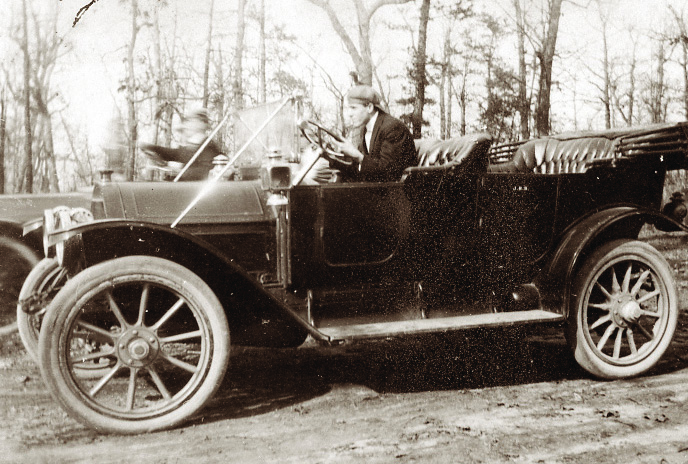The Chattanooga Southeast Tennessee Film Commission is trying to secure its share of the motion-picture pie for the Scenic City today, but nearly a century ago a national studio produced a number of silent films around the area from an office on Signal Mountain.
Signal Mountain resident Dale Smith, while thumbing through a scrapbook he bought at a recent estate sale in Brainerd, found photographs that apparently portray some of the actors, actresses and action that took place in and around the filming.
"I had no knowledge of a studio up there," he said.
The studio, a division of Essanay Film Manufacturing Co., began making films here in 1914 and apparently continued for several years.
"Chattanooga has been an Essanay town for the last four months," according to the Aug. 13, 1914, edition of the Philadelphia Evening Ledger. "Since the arrival of Captain E.H. Calvert, with 20 players from the Chicago studio of the Essanay Company, to produce pictures in Chattanooga and particularly in the mountains near here, the people of Chattanooga have treated the visitors royally.
"The company is spending the summer on Signal Mountain, 45 minutes from Chattanooga by trolley and 2,000 feet above the sea level. In addition to the beautiful scenic effects that can be secured in this section, almost every inch of ground has some historical interest to offer. Many pictures have already been filmed in the exact location that history has designated."
As late as 1924, the Chattanooga Sunday Times published a story and artist's rendering about a $4 million "movie colony" that was planned for Signal Mountain.
The colony was to include a 400-room hotel at Wilder Point, "a system of boulevards," homes for people working at the studio, parks and an artificial lake.
Although the story indicated one studio building was nearing completion, the colony apparently was never finished. Neither Essanay nor a film colony is mentioned in the town of Signal Mountain's online history.
We saw this east of our office in north Springdale.
Posted by NWADG on Wednesday, March 25, 2015
Nor are they mentioned in Cartter Patten's "Signal Mountain and Walden's Ridge" and "Images of America: Signal Mountain" by Mary Scott Norris and Priscilla N. Shartle.
Smith, who owns Estate Troopers, an estate sales and liquidations company, with his wife, LeeAnn, said he had no illusions about the worth of the photos but was curious about their historical place.
"I'm more fascinated by a $40 item than a $4,000 item," he said.
Smith's interest led him to call James L. Douthat, a Signal Mountain historian, who had mentioned the studio in some of his books.
The two believe at least 15 of the photographs from the album have some relation to the studio. Among them are portraits of a couple they believe to be Calvert and his wife, Lillian Drew, who starred in many of the movies.
Calvert, according to online histories, appeared in more than 170 films and directed 60, including some in the Chattanooga area.
In one of the photos, the actor is posed on a bridge clutching guns in both hands. In another, he leans forward at the steering wheel of an early roadster as he appears to simulate motion. Several other photos capture a man on the bluffs looking over what is obviously Signal Point. Each of the pictures has handwriting with the words "Signal Mountain."
The photos may be stills from the films, said Douthat, who theorized the mountain's terrain was a draw for the studio as well as a longer shooting season than in Chicago. "From the topography they're on, they have no reason to be there otherwise."
Smith said his research indicates the films were "very low budget" and were made for from $100 to $400. They ran from 300 feet to 1,000 feet of film, which he said was approximately 17 minutes.
Among the movies shot locally were "A Lesson in Romance," "Affinities," "The Man Trail," "Mind Over Motor" and "The Cave on Thundercloud."
The film's area office was at Signal Inn, now a part of Alexian Village, and movie footage was shot there, in area ballrooms and at the Faxon house, now the mansion portion of Hunter Museum of American Art, Smith said.
"Beautiful homes, with real Chattanooga society people as the extras, have been graciously thrown open to [Calvert]," according to the 1914 Philadelphia Evening Ledger article, "as had the Country Club and the Superior Courtroom, with the real judge, jurors [and] spectators carrying out those parts in the picture."
Essanay, according to online histories, produced more than 1,400 films from 1907 through 1918, when it was folded into a new company in a four-way merger. That new company was absorbed by Warner Brothers in 1925.
One of the studio's stars was Charlie Chaplain, who was hired away from Mack Sennett's Keystone Studios in 1914. He made 14 short comedies for Essanay in 1915, but there is no indication he ever worked in the Chattanooga area.
Calvert, according to Douthat, apparently stayed around longer than the studio. Census records from 1920 indicate the actor still lived in the area, he said.
He said the Great Depression, the death of Signal Mountain land owner C.E. James and other circumstances probably kept the movie colony from being built.
"It's a curiosity here," Douthat said. "I'd bet 90 percent of the people who live up here don't know anything about it."
David E. Johnson, deputy administrator of the city of Chattanooga Department of Education, Arts & Culture, under which the present film commission operates, said he was not familiar with the studio's work on Signal Mountain.

